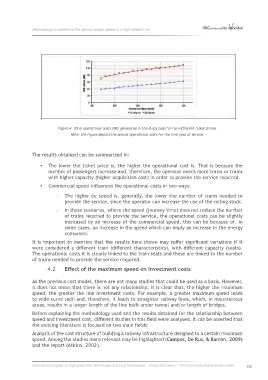Page 541 - 360.revista de Alta Velocidad - Nº 6
P. 541
Methodology to determine the optimal design speed in a High-Speed Line
Figure 4. Total operational costs (M€) generated in the study case for two different ticket prices.
Note: the figure depicts the annual operational costs for the first year of service.
The results obtained can be summarized in:
• The lower the ticket price is, the higher the operational cost is. That is because the
number of passengers increase and, therefore, the operator needs more trains or trains
with higher capacity (higher acquisition cost) in order to provide the service required.
• Commercial speed influences the operational costs in two ways:
- The higher de speed is, generally, the lower the number of trains needed to
provide the service, since the operator can increase the use of the rolling stock.
- In those scenarios, where the speed (journey time) does not reduce the number
of trains required to provide the service, the operational costs can be slightly
increased by an increase of the commercial speed, this can be because of, in
some cases, an increase in the speed which can imply an increase in the energy
consumed.
It is important to mention that the results here shown may suffer significant variations if it
were considered a different train (different characteristics), with different capacity (seats).
The operational costs it is clearly linked to the train seats and these are linked to the number
of trains needed to provide the service required.
4.2 Effect of the maximum speed on investment costs
As the previous cost model, there are not many studies that could be used as a basis. However,
it does not mean that there is not any relationship; it is clear that, the higher the maximum
speed, the greater the line investment costs. For example, a greater maximum speed leads
to wide curve radii and, therefore, it leads to straighter railway lines, which, in mountainous
areas, results in a longer length of the line built under tunnel and/or length of bridges.
Before explaining the methodology used and the results obtained for the relationship between
speed and investment cost, different studies in this field were analysed. It can be asserted that
the existing literature is focused on two main fields:
Analysis of the cost structure of building a railway infrastructure designed to a certain maximum
speed. Among the studies more relevant may be highlighted (Campos, De Rus, & Barrón, 2009)
and the report (Atkins, 2002).
International Congress on High-speed Rail: Technologies and Long Term Impacts - Ciudad Real (Spain) - 25th anniversary Madrid-Sevilla corridor 539

